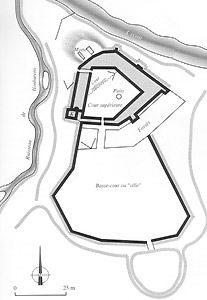|
Description of the castle
The whole of constructions
and the earthworks of the castle is extremely vast since it extends
on 230 meters length and 135 meters broad. Built on Gallo-Roman
foundations, one distinguishes four principal parts.
1 - The Mound
 In
north, where it was built in XIe century "the primarily made
primitive ground and wood castle". It was built on a rock headland
in the form of ten height meters very abrupt cone. Leaned with the
confluence of two rivers, Homburens and Ciron, only from the strings
from three to four meters of width separated some. A cut, visible
in the low court, isolated the fortress from the remainder of the
plate. Such is the origin of Cazeneuve. Two century later, it will
become the keep of a castle much vaster. In
north, where it was built in XIe century "the primarily made
primitive ground and wood castle". It was built on a rock headland
in the form of ten height meters very abrupt cone. Leaned with the
confluence of two rivers, Homburens and Ciron, only from the strings
from three to four meters of width separated some. A cut, visible
in the low court, isolated the fortress from the remainder of the
plate. Such is the origin of Cazeneuve. Two century later, it will
become the keep of a castle much vaster.
Nowadays, on this site, some rare cut stone sides remain the only
vestiges of this building.
2 - The castle
With the paddle of
XIVe century, Amanieu VII of Albret decided to build, coupled with
the primitive castle, significant an castle-enclosure. Enclosing
a vast interior court, it marries the shape of an irregular polygon,
similar to the current plan.
Always delimited by the course of Ciron and Homburens, the medieval
fortress is extended to the south towards the plate from which it
is separated by dry ditches. A drawbridge separates it from the
first enclosure.
The current castle is built with the whole beginning of XIVe century,
by Amanieu VII of Albret, it is Raymond de Vicose in the years 1600-1610
who undertakes his restoration because it was said it "uninhabited
and uninhabitable" because of devastations of the war.
The architectural juxtaposition of these two times confers on the
unit a specificity and an aspect with no one another similar. Austere
and defensive medieval elements cohabit harmoniously with ostentation
and the gracious pace and more smiling of XVIIe announcing the century
close to the Lights.
One penetrates in the enclosure of the castle Thanks to a bridge
with two arches spanning the dry ditches. On both sides bridge,
a balustrade out of stone ends in two base plates of square pillars
which supported formerly the drawbridge.
A large gate whose pilasters Tuscan support a armorié blazon
and a broken pediment opens on the main courtyard. The broad passage
cut in the thickness of the wall marries a skewed form which made
it possible the horse-drawn carriages to arise vis-a-vis the door
of principal entry of the home seigneurial. Above, a gallery discovered
bordered of stone balusters reduces this old moyenâgeux wall...
3 - The town of
Cazeneuve
Forming integral part
of the great intention of Amanieu VII, the town of Cazeneuve was
a true borough where a whole town life grouillait. It had its own
notaries and later Charles II will say being "dominus city
and castri casenove".
It extended in front of the castle beyond the ditches and was delimited
by an enclosure made up of high crenelated ramparts. The foot of
this thick wall, broad ditches not frames ensured an additional
defense. The access was done by a drawbridge.
At the interior were constructions and on the left entry, gardens
with the Frenchwoman undoubtedly drawn tardily at the XVIIe century.
Defenses of this city were strongly damaged by the successive wars.
The ditches were definitively embanked in April 1862.
Today still remains the door of entry of the city, in gothic arch
known as "triumphal arch" and most of the wall is which
is used as support with more recent constructions.
4 - The Weephole
The entry of the town
of Cazeneuve was protected by a advanced construction: a powerful
weephole called "Turn of Lusignan". The wall also rested
on a ground monticule of sixty measuring apparatuses of circuit
and surrounded it of ditches. The weephole, first defensive point
of avant-garde, served to some extent as "hopper" because
it was first of all necessary to penetrate in this court. From there,
a first drawbridge bent down to give access in the city. A second
kept the entry of the castle. The tower of Lusignan disappears definitively
in the years 1880.
Writen by Madam
Edith de Sabran-Pontevès but not translated
|



 In
north, where it was built in XIe century "the primarily made
primitive ground and wood castle". It was built on a rock headland
in the form of ten height meters very abrupt cone. Leaned with the
confluence of two rivers, Homburens and Ciron, only from the strings
from three to four meters of width separated some. A cut, visible
in the low court, isolated the fortress from the remainder of the
plate. Such is the origin of Cazeneuve. Two century later, it will
become the keep of a castle much vaster.
In
north, where it was built in XIe century "the primarily made
primitive ground and wood castle". It was built on a rock headland
in the form of ten height meters very abrupt cone. Leaned with the
confluence of two rivers, Homburens and Ciron, only from the strings
from three to four meters of width separated some. A cut, visible
in the low court, isolated the fortress from the remainder of the
plate. Such is the origin of Cazeneuve. Two century later, it will
become the keep of a castle much vaster. 
